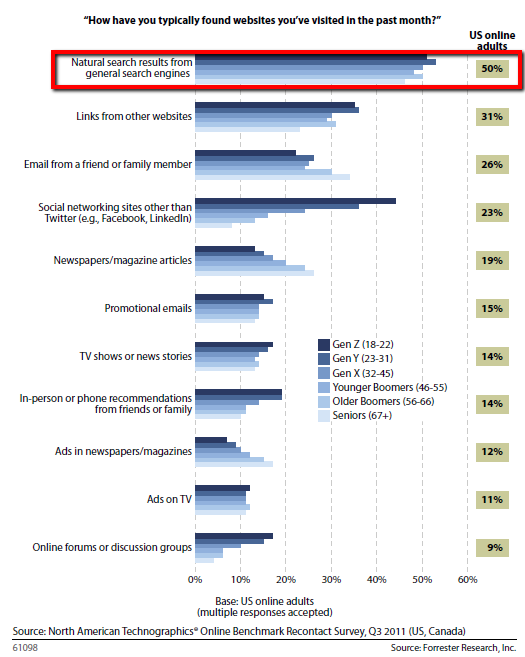 So what resources do consumers use to help them find websites? It’s a good question to answer as you’re thinking about how to prioritize your marketing efforts. I often talk about the importance of natural search visibility as a foundation to a 360 degree marketing program (surrounding your prospects and customers via many touch points- search, social, online and offline channels), and there’s a good reason for that. Forrester took a look at their 2011 consumer survey data on how US adults get to sites and found that by far the largest percentage—50%– find sites through organic search. As Forrester analyst Shar VanBoskirk reported: “natural search still beats the second-most common site-traffic driver — links from another site — by 19% (it also beats paid search by a whopping 42%- as navigation via paid links comes in at 8%).
So what resources do consumers use to help them find websites? It’s a good question to answer as you’re thinking about how to prioritize your marketing efforts. I often talk about the importance of natural search visibility as a foundation to a 360 degree marketing program (surrounding your prospects and customers via many touch points- search, social, online and offline channels), and there’s a good reason for that. Forrester took a look at their 2011 consumer survey data on how US adults get to sites and found that by far the largest percentage—50%– find sites through organic search. As Forrester analyst Shar VanBoskirk reported: “natural search still beats the second-most common site-traffic driver — links from another site — by 19% (it also beats paid search by a whopping 42%- as navigation via paid links comes in at 8%).
So why does organic search have such a huge lead when it comes to the sources consumers turn to? It comes down to trust. As VanBoskirk has written:
“…natural search results are among the most trusted information resources; 57% of consumers between the ages of 12 and 17 and 39% of adult ages 18-plus say they trust search engine results. In fact, more consumers trust natural search results than TV, company email updates, and social network profiles”.
While natural search decreased 11% from 2010 to 2011, being highly visible in organic search is still by far the leader in getting people to your site according to the data:
The other big headline from the 2011 data is the rapid growth of social media as a driver of traffic. Social network sites other then Twitter (Facebook, LinkedIn) jumped from 16% to 27% from 2010 to 2011. And when you look at “Generation Z” (adults age 18-22), the data is even more pronounced- 44% of that segment use social media to find sites- clearly indicating where the future is going.
Obviously, the way that we are looking at this data biases us toward thinking of only “one source” as the sole driver. What happens in the real world is that consumers often see many forms of communication that collectively help them take action, but often only think of the last step that influenced what they did. As Forrester has noted,
Multiple marketing touchpoints may drive a single site visit. Consumers now use myriad marketing channels to find the web experiences they want. For example, 20% search after seeing an online ad instead of clicking through to a site. Another one in four adults type in a website URL directly but only after they see ads in offline media like TV, newspapers, and radio.
The bottom line? Organic search optimization should be a foundation of your 360 degree marketing program, and social media optimization should be right there with it.


 I’ve been working in marketing and advertising since 1985, online marketing since 1992, and had my first experience with the revolution that is search working with the pioneering AltaVista search engine in 1996. I’ve run $100 million TV campaigns for Fortune 500 companies and lived the wonderful, reliable era of mass advertising and long client lunches by the Four Seasons LA pool. And what I can tell you having done this for a while is the safe and predictable orbit of your marketing universe has ended. If you are a marketer, advertiser or just a business trying to get a few customers, disruption is here. All that you need to do to get done what you need to get done, is changing very quickly. Social Media, Content Marketing, Search Engine Optimization, Paid Search, Analytics and Mobile Marketing are revolutionizing the way you get people to buy whatever it is you’re selling. And you either need to get on the bus and starting tooting the horn, or at the very least figure out how not to get run over. This blog is here to help you do that.
I’ve been working in marketing and advertising since 1985, online marketing since 1992, and had my first experience with the revolution that is search working with the pioneering AltaVista search engine in 1996. I’ve run $100 million TV campaigns for Fortune 500 companies and lived the wonderful, reliable era of mass advertising and long client lunches by the Four Seasons LA pool. And what I can tell you having done this for a while is the safe and predictable orbit of your marketing universe has ended. If you are a marketer, advertiser or just a business trying to get a few customers, disruption is here. All that you need to do to get done what you need to get done, is changing very quickly. Social Media, Content Marketing, Search Engine Optimization, Paid Search, Analytics and Mobile Marketing are revolutionizing the way you get people to buy whatever it is you’re selling. And you either need to get on the bus and starting tooting the horn, or at the very least figure out how not to get run over. This blog is here to help you do that.
Pingback: Local Digital Marketing Basics: A Quick Primer on Priorities | John H. Denny